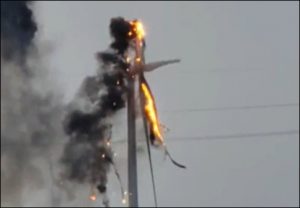Posted on Saturday, 6th August 2022 by Dennis Damp
 Print This Post
Print This Post
Please forward this article to others that may find it informative.
This past winter our gas and electric bills doubled from the previous year. Both companies confirmed that my usage was about the same year to year. Inflation has taken its toll and we simply can’t escape the spiraling costs of everything these days.

Why are our electricity costs increasing when we have nuclear, abundant coal, and gas to power the country? Obviously, more power plants are needed; it didn’t take long to find out why.
Higher prices are near and dear to those planning their retirement and annuitants a like. With our abundant energy resources our utility bills should be much lower.
EMPOWERING OUR GRID
America is facing rolling brown outs this year; we no longer have sufficient electric generation capacity during extreme weather events. This wasn’t caused by climate change; the problem is manmade. Over 300 coal fired power plants were forced to close since 2010, mostly due to onerous new EPA regulations and cost considerations.
A third of the coal plants that closed were either converted to natural gas or replaced with new gas fired plants. A new EPA wastewater rule will cause 75 additional coal fired plants across the country to shut down if the rule isn’t rescinded.
Six nuclear power plants closed since 2013. Europe is reopening mothballed coal fired and nuclear facilities to shore up their electric grid, it seems like a reasonable course of action for us here at home.
India, China, and Japan are building hundreds of new high efficiency low emission (HELE), ultra-supercritical coal-fired power plants. EPA regulations discourage the building of HELE coal-fired power plants in the US even though these power plants have a Higher Heat Value (HHV) rating of 45% then our existing fleet of coal-fired power plants in the US that have an average efficiency of 33% HHV. The life expectancy of a HELE plant is 60 years compared to just 20 years for wind-turbines and solar farms.
According to the Institute of Energy Research (IER), “1,600 coal plants are planned or under construction in 62 countries. If constructed, these new plants would increase global coal-fired capacity by 43 percent.” In many cases these plants will use our exported coal to fuel their power grid. We should be building low emission HELE plants where needed to utilize our vast coal resources and shore up our grid.
Solar and wind projects are planned that will help. The Energy Information Administration (EIA) announced plans to deploy 21.5 GW of solar and 7.6 GW of wind in the U.S. in 2022 that would surpass the estimated 15.5 GW of solar additions in 2021.
However, wind and solar are weather dependent, during cloudy or low wind velocity days, little to no power is generated; it would cost a fortune to store their energy in huge stationary batteries to supplement supply during critical periods.
Renewables are fairly unreliable and often require huge government loan guarantees and grants. Remember the Texas wind-turbines that shutdown during freezing temperatures, California’s usage restrictions this year, and the bankrupt Crescent Dunes concentrated solar power company that shut down in 2020. This company was developed with $737 million in U.S. Department of Energy loan guarantees! Solyndra LLC was another solar panel manufacturer that received over $500 million in government funding that went bankrupt in 2011.

Wind-Turbine Struck by Lightening in Texas
We must have a ready reserve of sustainable carbon-based power sources that can be the mainstay of our grid for the foreseeable future. Renewables will eventually provide a larger percentage of our needs, but we shouldn’t abandon or discourage the building of reliable new high efficiency carbon-based and nuclear power generation options.
To make matters worse, we currently have 93 nuclear reactors located at 55 nuclear power plants in 28 states that generate 20 percent of our power needs according to the US Energy Information Agency. Twenty-one reactors are scheduled for decommissioning!
In 2016, the Tennessee Valley Authority’s (TVA) Watts Bar Unit 2 in Tennessee became the first new U.S. reactor to come online since 1996. Two others in Georgia are under construction and will add approximately 4,234 megawatts (MW) combined when they go online; enough to power over 500,000 homes! Compare this to 29.1 MW of solar and wind projects that are planned for 2022.
One of the downsides to nuclear is waste disposal. It needs to be properly handled in new and existing plants. They currently store much of it on site in large steel containers. A catastrophe waiting to happen. Another reason to retain and expand our carbon-based energy production.
ELECTRIC VEHICLES (EVs) – Roadblocks Ahead
EVs are here to stay and owners overall seem to love them. However, the push to dramatically increase EV production and sales is irresponsible. Our infrastructure and electric grid can’t handle this without decades long upgrades and many homes would require electrical modifications as well. The high cost prohibits most from purchasing one. Yes, costs may come down over time, but not in the near future. Especially with batteries tripling in price.
It isn’t just their initial cost, it’s the higher costs we are destined to pay for electricity after plugging them in at home. My electric bills increased dramatically over the past two years.
EVs make sense for local trips, daily commutes, and for those who can afford one. A viable option for a second car from my perspective. Hybrids are another option, their batteries cost less. It should be noted that driving a hybrid with a dead battery can cause irreparable damage to your hybrid system.
For the foreseeable future, a reliable gas-powered vehicle or possibly a hybrid would be required for a family’s primary mode of transportation. Costs can be prohibitive for EVs overall when you factor in a few variables.
EV RANGE RATINGS – REALLY!
Manufactures of EVs provide a mileage range rating under ideal conditions, typically from the mid-200s to 350 miles per full charge. Those estimates don’t take into account extreme weather, mountainous terrain, etc. Mileage range decreases 40% to 50% if you’re running a heater or the AC, operating the vehicle in bad weather that increases drag, or have many hills to climb during your journey.
EVs with a stated range of 300 miles would realistically be around 150 to 170 miles and require more frequent charging and higher electric bills for owners. Batteries over time lose their full charge capabilities, just check your mobile phone’s battery health, mine is at 84%.
EV BATTERY REPLACEMENT COSTS
Replacement batteries cost an arm and a leg if you can get one. A friend of mine purchased a Chevy Bolt several years ago. The battery died while under warranty and it took over a year for the new battery to arrive; the installation was a nightmare. A Chevy Bolt battery costs over $16,000!
KVUE TV, an ABC affiliate in St Peterburg, Florida, reported that a 17-year-old’s parents spent $11,000 on a used 2014 Ford Focus Electric with 60,000 miles. Six months later the battery died; the replacement cost was $14,000! A Tesla owner in Sweden blew up his car last year to protest the $18,000 replacement battery cost!
THERE ARE NO FREE RIDES
Currently, Fuel taxes account for 84 percent of federal and 29 percent of state highway funds. As we transition to a greater percentage of EVs on the road, these funds have to be collected through other methods. Many states already doubled the registration fees for EVs. Tolls on roads and bridges will increase accordingly since all vehicles will pay the same fee.
EV owners will eventually pay not only for the electricity used whenever they stop for a recharge, taxes will be applied. Those who charge from home will surely pay an add-on-tax to their monthly electricity bill, especially for those who install fast chargers in their garage.
After all is said and done, EVs won’t be less expensive than a typical internal-combustion-engine car down the road. You also have to factor in battery deposal fees that could be very high. Batteries are considered hazardous waste and will create disposal problems down the road even if they are able to recycle them with new electrolyte.
SUMMARY
All sources should be explored and used to provide efficient and reliable power for residential and commercial use, one size doesn’t fit all. A push to fast-track EVs in support of the administration’s outrageously expensive climate change agenda is destined to fail if we don’t step back and adjust our expectations.
These fast-tracked initiatives have devastating impacts on those who can least afford it.
Unfortunately, the elites, power brokers, and many of our representatives don’t comprehend the plight of the average American. They have unlimited resources, live in gated communities with private security details, aren’t subject to the same rules and regulations they espouse, travel in private jets and only care about their agenda while the majority of American’s suffer from their incompetence.
Special interests and their lobbyists have taken over Washington and are driving these initiatives before they are viable and ready for prime time.
Helpful Retirement Planning Tools
- Retirement Planning for Federal Employees & Annuitants
- The Ultimate Retirement Planning Guide – Start Now
- TSP Guide
- TSP Considerations
- Medicare Guide
- Medicare and FEHB Options – What Will You Do When You Turn 65? (Part 1)
- Budget Work Sheet
- Social Security Guide
Disclaimer: The information provided may not cover all aspect of unique or special circumstances, federal regulations, medical procedures, investment, and benefit information are subject to change. To ensure the accuracy of this information, contact relevant parties for assistance including OPM’s retirement center. Over time, various dynamic economic factors relied upon as a basis for this article may change. The information contained herein should not be considered investment advice and may not be suitable for your situation. This service is not affiliated with OPM or any federal entity. You should consult with a financial, medical or human resource professional where appropriate. Neither the publisher or author shall be liable for any loss or any other commercial damages, including but not limited to special, incidental, consequential, or other damages.
Last 5 posts by Dennis Damp
- Open Season Coming to a Close – Last-Minute Checkup - December 2nd, 2025
- I Rolled Over My TSP Account to an IRA – Should You? - November 21st, 2025
- The 2026 FEHB & PSHB Open Season Selection Guide - November 6th, 2025
- Medicare & You 2026 – Significant Changes on the Way - October 31st, 2025
- A 30-second Check Could Change Your Retirement Plan - October 20th, 2025
- Prescription Drug Costs – Major Price Cuts Coming - October 17th, 2025
- Government Shutdown Continues – Suffering the Consequences - October 15th, 2025
- Health Care Premiums Announced for 2026 – Hold on to your Hat! - October 13th, 2025
- Inflation Concerns and High Prices Persist – What’s Next - October 10th, 2025
- Roth Conversion Article Update and Income Tax Impact - September 25th, 2025
- TSP Traditional to ROTH IRA Conversions Coming Soon - September 19th, 2025
- TSP Required Minimum Distributions, Annuities, and Transfers - September 5th, 2025
Tags: Electric Vehicle Concerns, EV Battery Costs, EV Issues, Power GXrid, Power GXrid Problems
Posted in LIFESTYLE / TRAVEL, RETIREMENT CONCERNS, SURVIVOR INFORMATION, WELLNESS / HEALTH | Comments (2)
 Print This Post
Print This Post


August 12th, 2022 at 1:42 pm
Attempting to obtain a Letter of Proof of FEGLI for immigration application requirements
October 17th, 2022 at 1:16 pm
Contact OPM, they can send one out. Their number is 1-888-767-6738. If you are a registered user of OPM’s Retirement Services online you can download this document. To register for their online services visit https://fedretire.net/connect-to-opm-retirement-services-online/.